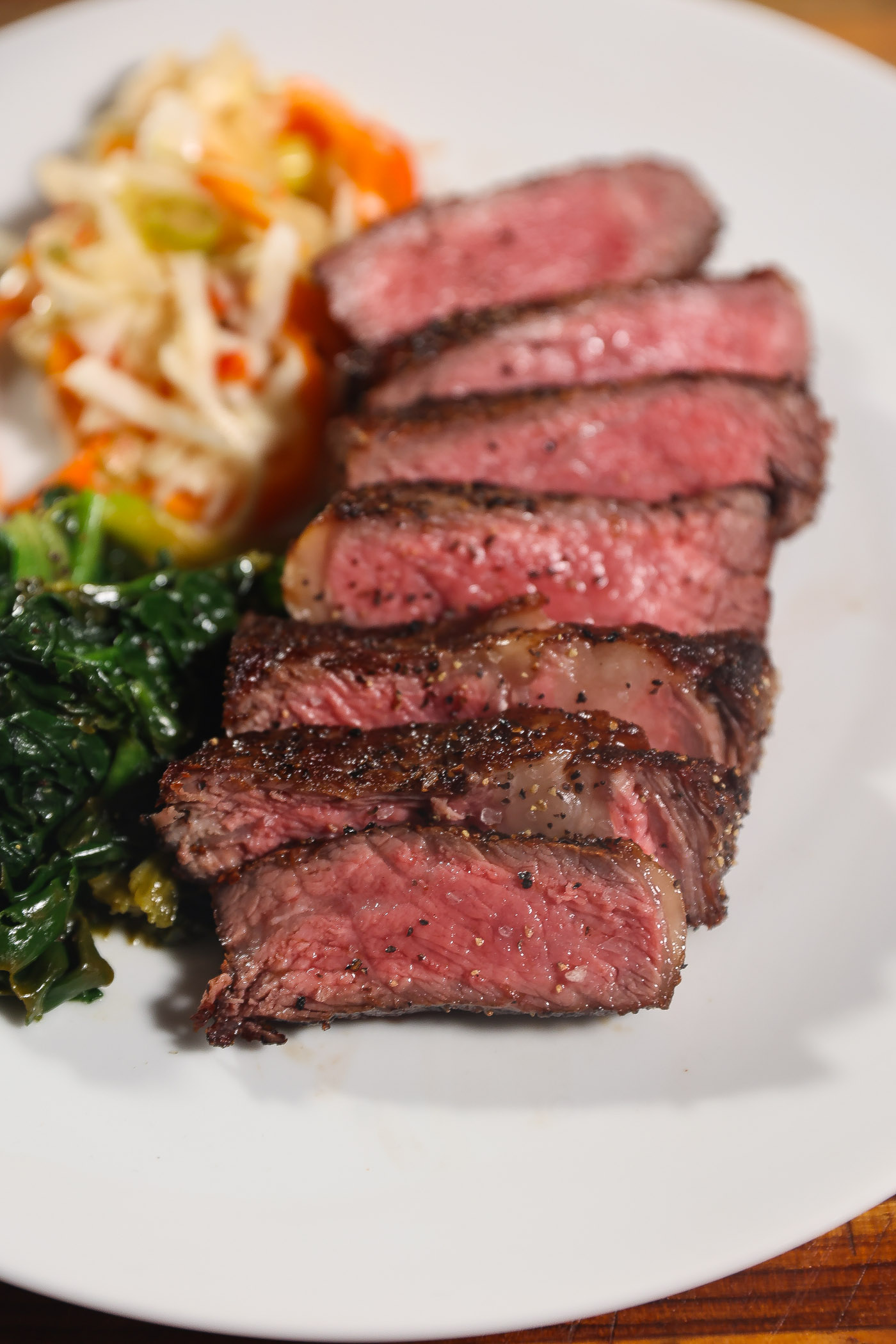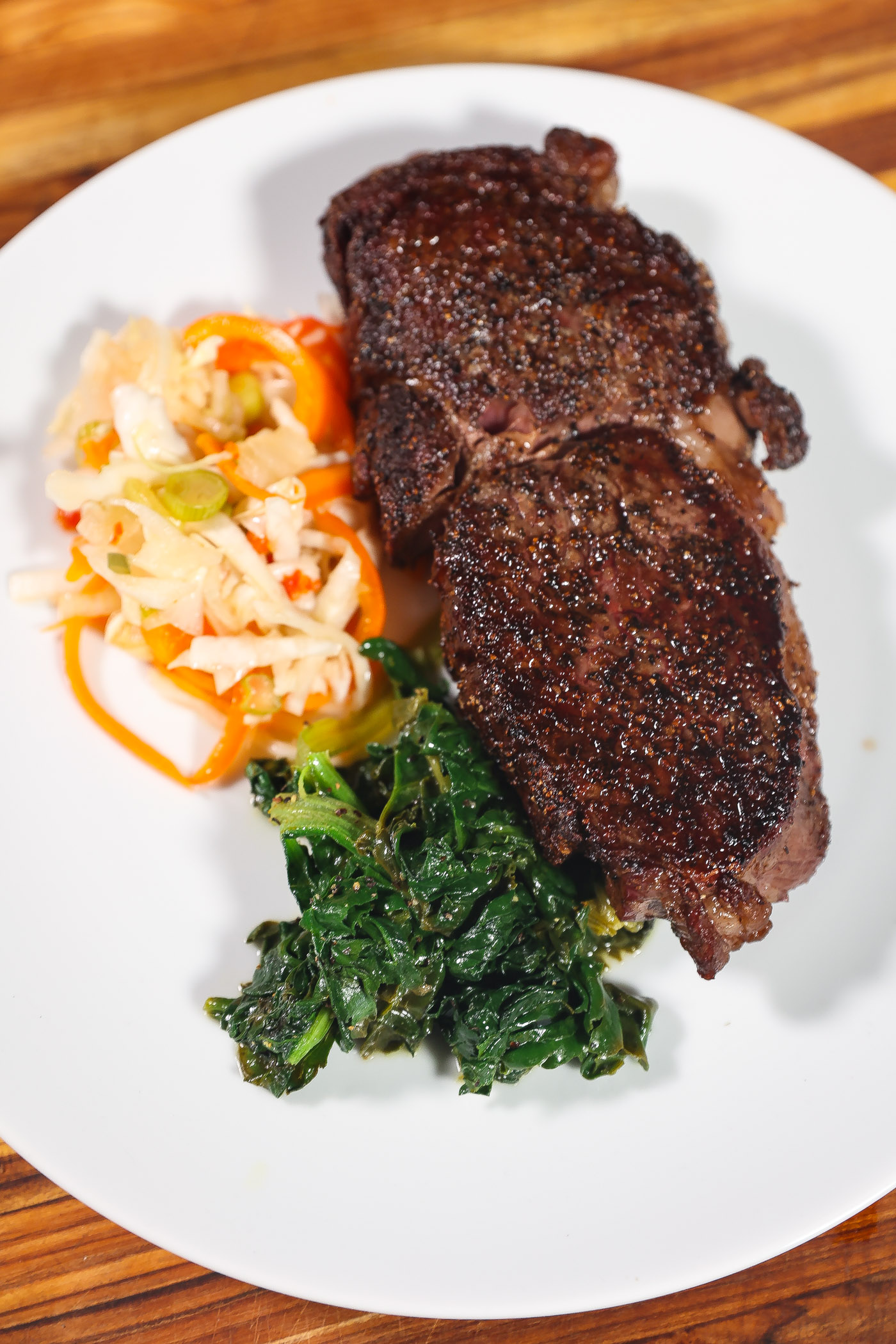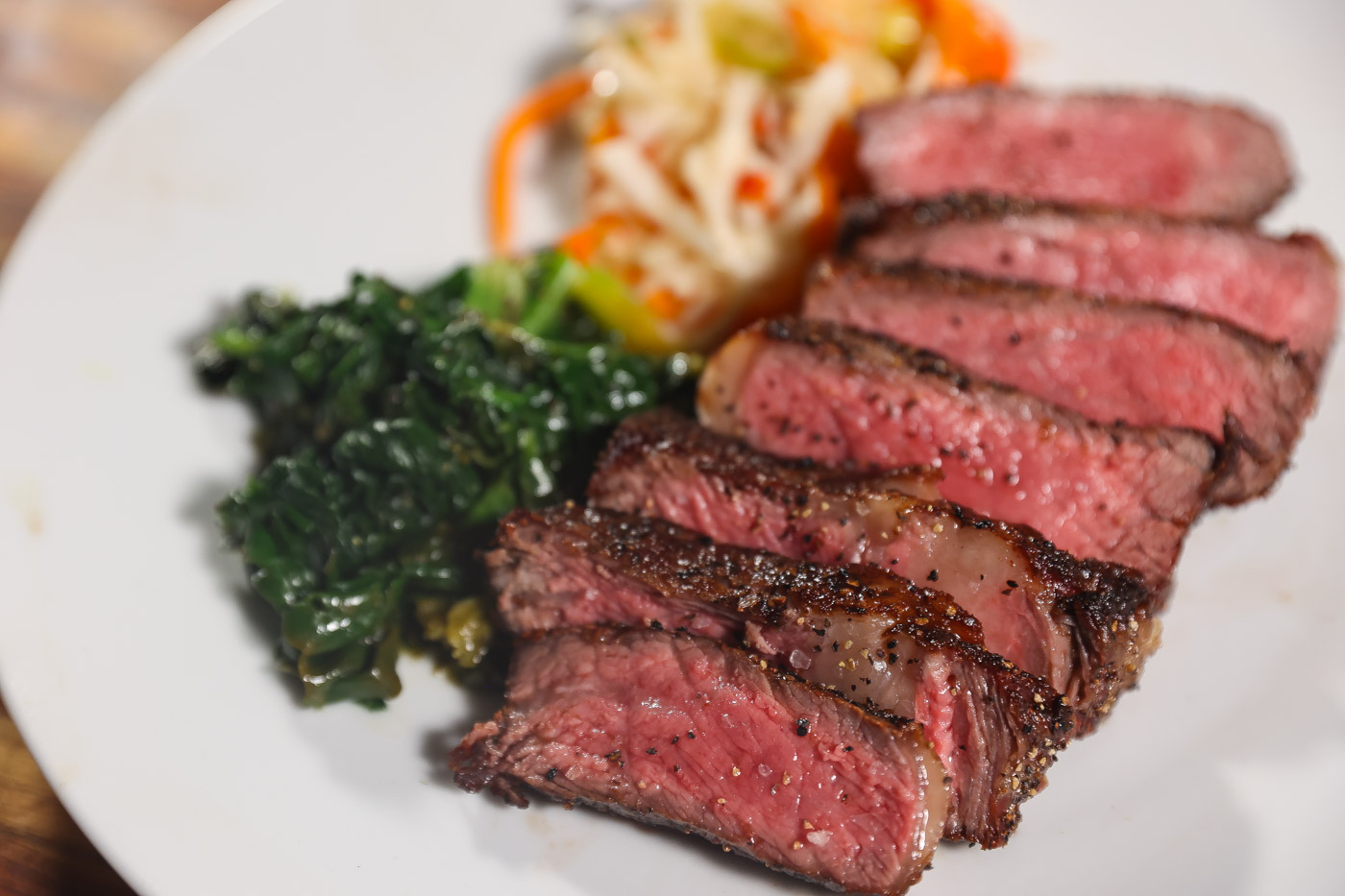Cooking the perfect reverse seared ribeye steak is an art like no other; it's a culinary experience that can turn even the most novice cook into a master chef. With its mouth-watering taste and tender texture, this cut of meat never fails to leave its diners satisfied.
If you're trying your hand at cooking up one of these beautiful steaks for yourself or loved ones and want to know how to make a reverse ribeye, you'll find all the expert tips and tricks in this blog post that will take your meal from delicious to unforgettable!

What Is Reverse Searing
Reverse searing is a method of cooking steak where the steak is first cooked at a low temperature, usually in an oven or on a grill, until it reaches the desired internal temperature. The steak is then finished by searing it on high heat to develop a crispy crust on the outside. This method helps to create a more evenly cooked steak with a crust that is more evenly browned, while reducing the risk of overcooking or burning the steak.
Beats and Eats (music to pair with ribeye steak)
A ribeye is just a steak, but when cooked right it becomes a magical thing. When done right it has a perfect crispy crust on the inside with a juicy center on the inside. In this big transformation it is like black magic - free and beautiful!
Why Reverse Sear Steak Method Works
Reverse searing works for several reasons:
- Even cooking: By cooking the steak at a low temperature first, the heat is able to penetrate the steak more evenly from the outside in, resulting in a more evenly cooked steak.
- Control of internal temperature: By cooking the steak at a low temperature first, it is easier to achieve the desired internal temperature without overcooking the outside of the steak.
- Maillard reaction: The high heat of the sear creates the Maillard reaction, a chemical process that gives the steak a flavorful crust and color.
- Resting time: The low temperature cooking allows for more resting time before searing, which allows for more juices to be reabsorbed and for the steak to be more tender and flavorful.
Disadvantages of the Reverse Searing Process
While reverse searing is a popular and effective method for cooking steaks, there are a few potential disadvantages to consider:
- Time: Reverse searing takes longer than other methods, as the steak needs to be cooked at a low temperature first. This may not be ideal if you're short on time.
- Equipment: Reverse searing requires an oven or a grill, as well as a thermometer to monitor the internal temperature of the steak.
- Smoke: If you're searing the steak on a grill, the high heat may cause some smoke, which could be an issue if you're cooking indoors.
- Less crust: Some people may prefer a thicker, more pronounced crust on their steak, which can be achieved by searing first and then cooking the steak to the desired internal temperature. With reverse searing, the crust is typically thinner.
- Texture: While reverse searing can result in a very evenly cooked steak, some people may prefer a steak that is more charred on the outside, which is difficult to achieve with this method.
Ingredients Needed To Reverse Sear A Ribeye Steak
- Ribeye Steak
- Course Salt (Sea Salt or Kosher Salt)
- Course Black Pepper
- High Smoke Point Oil/Fat - Ghee, Grapeseed Oil, Peanut Oil
- Unsalted Butter (optional)
How to Reverse Sear Ribeye Steak
Season the steak with salt and pepper after it reaches room temperature.
Preheat oven to 275 degrees F.
Line a rimmed baking sheet with a wire rack. Place the steak on the rack and add it to the oven.
Bake for about 20-25 minutes until temp reaches 90 degrees for perfect medium rare.
Check the temperature at 15 minutes and then continue cooking as needed until the desired temperature is reached. Time will depend on the size and thickness of the steak. Mine was 16 oz and took 25 minutes.
While the steak is cooking allow your cast iron skillet to heat in oven simultaneously as well.
When ready remove cast iron pan from oven and heat on the stovetop on high heat. Once hot add ghee or other high smoke point oil to the hot pan.
Add the steak to the hot skillet and sear 2 minutes per side. As an option you can add butter to the pan and baste the steak with the melted butter.
Remove steak and serve. Note: with reverse searing you don't have to let the steak rest.

What to serve with ribeye steaks
Serve your ribeye steak as the main course with side dishes like sauteed spinach, roasted potatoes, or broccolini.
Cooking Tips, Considerations, and Substitutions
Here are a few tips for reverse searing ribeye steaks:
- Start with a thick cut steak: Reverse sear thick steaks like ribeyes that are at least 1.5 inches thick work best with the reverse sear method. Thinner cuts may overcook on the inside before developing a good crust on the outside.
- Season generously: Season the steak simply with salt and pepper or your preferred steak seasoning.
- Preheat the oven or grill: Preheat the oven to a low temperature (around 250-275°F) or prepare your grill for indirect heat. This will allow you to cook the steak slowly and evenly without overcooking it.
- Use a meat thermometer: To ensure that the steak is cooked to your desired level of doneness, use a meat thermometer to monitor the internal temperature. For medium-rare, cook the steak to an internal temperature of 125°F, and for medium, cook to 135°F.
- Rest the steak before searing: Once the steak reaches your desired internal temperature (90 degrees pre-searing for med rare), remove it from the oven or grill and let it rest for 10-15 minutes before searing. This will allow the juices to redistribute and ensure a juicy, tender steak.
- Sear on high heat: Heat a cast iron skillet or grill to high heat and sear the steak for 1-2 minutes per side. This will develop a flavorful crust and enhance the overall taste of the steak.
- Baste with butter: For extra flavor, baste the steak with melted butter and garlic during the searing process. This will add richness and depth of flavor to the steak.
Overall, these tips will help you achieve a perfectly cooked, delicious ribeye steak using the reverse sear method.
Here are some considerations to keep in mind when making reverse seared steak:
- Quality of the steak: Start with a high-quality cut of steak for the best results. Look for a steak that is well-marbled and has a good amount of fat, as this will help to develop flavor and create a juicy, tender steak
- Temperature control: Consistent temperature control is important when reverse searing. Use an oven or grill thermometer to monitor the temperature and make sure it stays at a low temperature (around 250-275°F) for the initial cooking process. Then, increase the heat to high for the searing process.
- Searing the steak: Use a cast iron skillet or grill for the searing process. Make sure the skillet or grill is hot before adding the steak, and don't overcrowd the pan or grill to ensure the steak develops a good crust.
By keeping these considerations in mind, you'll be able to achieve a delicious, perfectly cooked steak using the reverse sear method.
If you don't have the equipment or time to use the reverse sear method to cook ribeye steaks, here are a few substitutions you can consider:
- Pan-seared ribeye: Instead of using the reverse sear method, you can pan-sear the ribeye steak. Preheat a cast iron skillet over high heat, and then add a small amount of oil or butter to the skillet. Sear the steak for 2-3 minutes on each side, or until a crust forms, and then finish cooking in the oven or on the stovetop until the desired level of doneness is reached.
- Grilled ribeye: If you have a grill, you can grill the ribeye steak over high heat. Season the steak with salt and pepper or your preferred seasoning, and then grill the steak for 4-5 minutes on each side for medium-rare, or until the desired level of doneness is reached.
- Broiled ribeye: Preheat the broiler and place the ribeye steak on a broiler pan. Broil the steak for 4-5 minutes on each side for medium-rare, or until the desired level of doneness is reached.
Overall, these substitutions may not give you the same level of flavor and texture as the reverse sear method, but they can still result in a delicious, perfectly cooked ribeye steak. Just be sure to adjust the cooking time and temperature based on the thickness and composition of the meat to ensure it's cooked to your liking.
Frequently Asked Questions About Reverse Searing Steaks
How Is Reverse Sear Steak Different from Sous Vide Steak?
Reverse sear and sous vide are two different methods of cooking steak, and each has its own advantages and disadvantages. Here are some key differences:
- Cooking method: With reverse searing, the steak is first cooked in the oven or on a grill, then seared on high heat to develop a crust. With sous vide, the steak is vacuum-sealed in a plastic bag and cooked in a precisely controlled water bath.
- Temperature control: Sous vide allows for very precise temperature control, as the water bath can be set to the exact temperature desired. With reverse searing, it can be more difficult to achieve precise internal temperatures, especially if you're using a grill.
- Texture: Sous vide is known for producing very tender, evenly cooked steak with a consistent texture throughout. Reverse searing can also produce a tender steak, but it may be more difficult to achieve a consistent texture throughout. Though is no crust achieved with sous vide. You will have to add the extra searing step to get that nice crispy crust.
- Time: Sous vide generally takes longer than reverse searing, as the steak needs to cook in the water bath for an extended period of time. Reverse searing can be faster, as the steak only needs to cook at a low temperature for a short time before being seared.
- Equipment: Sous vide requires a sous vide machine and vacuum sealer, which may not be readily available in every kitchen. Reverse searing requires an oven or grill, but is otherwise a relatively simple method that can be done with basic kitchen tools.
Does the Reverse Sear Method Change for Different Cuts?
The reverse sear method can be applied to a variety of steak cuts, but the cooking time and temperature may need to be adjusted depending on the specific cut. For example:
- Thicker cuts: Thicker cuts of steak, such as ribeye or porterhouse, will require longer cooking times at a low temperature to achieve the desired internal temperature. It's important to use a meat thermometer to ensure that the steak is cooked to the correct internal temperature.
- Lean cuts: Leaner cuts of steak, such as filet mignon or sirloin, may not benefit as much from the reverse sear method, as they don't have as much fat to render and develop flavor. However, the method can still be used to achieve a more even cook and a flavorful crust.
- Tougher cuts: Tougher cuts of steak, such as flank or skirt steak, can benefit from the reverse sear method, as the low temperature cooking can help to break down the connective tissue and make the steak more tender.
Overall, the reverse sear method can be used with most cuts of steak, but it's important to adjust the cooking time and temperature based on the thickness and composition of the meat.
What Type of Cuts Work Well with Reverse Searing?
The reverse sear method works well with a variety of steak cuts, but generally works best with thicker cuts of steak. Here are a few examples of cuts that work well with reverse searing:
- Ribeye: Ribeye is a popular cut for reverse searing because of its marbling, which helps to render the fat and develop a flavorful crust.
- Strip steak: Strip steak is another good choice for reverse searing, as it has a good balance of fat and flavor.
- Filet mignon: While filet mignon is a leaner cut of steak, it can still benefit from the reverse sear method to achieve a more even cook and a flavorful crust.
- Porterhouse and T-bone: These cuts are typically quite thick, which makes them ideal for the reverse sear method.
- Tomahawk: Tomahawk steak is a thick, bone-in ribeye that is well-suited to the reverse sear method because of its thickness and marbling. The long extened bone can be problematic for stovetop and oven, otherwise you'll need to cut the bone (have you butcher do this).
Overall, the reverse sear method can be used with a wide variety of steak cuts, but it's important to adjust the cooking time and temperature based on the thickness and composition of the meat.
Make This Recipe
This recipe for the perfect reverse seared ribeye steak is sure to impress your guests. The best part is that it's actually quite simple to make. With just a few minutes of prep time and a little bit of patience, you'll be enjoying a delicious steak dinner in no time. So what are you waiting for? Give this recipe a try tonight!
If you make this juicy steak recipe or any other recipe please come back and leave me a comment below with your feedback. Definitely take a photo of the dish and be sure to tag #foodfidelity so that I can see them.
You can also keep up with my food exploits as well as original recipes! You can find me on Instagram, Facebook, Twitter, and Pinterest. If you like any of the music you find on the site, visit me at Spotify to find curated monthly playlists.
Lastly, go to my YouTube channel and subscribe to be notified when new weekly videos are uploaded.
Ingredients
- 16 oz Ribeye Steaks
- 1 teaspoon Course Salt Sea Salt or Kosher Salt
- 1 teaspoon Course Black Pepper
- 2 tablespoons Ghee Grapeseed Oil, Peanut Oil
- 1 tablespoon Unsalted Butter optional
Instructions
- Season the steak with salt and pepper after it reaches room temperature.
- Preheat oven to 275 degrees F.
- Line a rimmed baking sheet with a wire rack. Place the steak on the rack and add it to the oven.
- Bake for about 20-25 minutes until temp reaches 90 degrees for perfect medium rare.
- Check the temperature at 15 minutes and then continue cooking as needed until the desired temperature is reached. Time will depend on the size and thickness of the steak. Mine was 16 oz and took 25 minutes.
- While the steak is cooking allow your cast iron skillet to heat in oven simultaneously as well.
- When ready remove cast iron pan from oven and heat on the stovetop on high heat. Once hot add ghee or other high smoke point oil to the hot pan.
- Add the steak to the hot skillet and sear 2 minutes per side. As an option you can add butter to the pan and baste the steak with the melted butter.
- Remove steak and serve. Note: with reverse searing you don't have to let the steak
Video

Notes
- Start with a thick cut steak: Reverse sear thick steaks like ribeyes that are at least 1.5 inches thick work best with the reverse sear method. Thinner cuts may overcook on the inside before developing a good crust on the outside.
- Season generously: Season the steak with salt and pepper or your preferred steak seasoning at least an hour before cooking. This will allow the flavors to penetrate the meat and enhance the final taste.
- Preheat the oven or grill: Preheat the oven to a low temperature (around 200-250°F) or prepare your grill for indirect heat. This will allow you to cook the steak slowly and evenly without overcooking it.
- Use a meat thermometer: To ensure that the steak is cooked to your desired level of doneness, use a meat thermometer to monitor the internal temperature. For medium-rare, cook the steak to an internal temperature of 125°F, and for medium, cook to 135°F.
- Rest the steak before searing: Once the steak reaches your desired internal temperature, remove it from the oven or grill and let it rest for 10-15 minutes before searing. This will allow the juices to redistribute and ensure a juicy, tender steak.
- Sear on high heat: Heat a cast iron skillet or grill to high heat and sear the steak for 1-2 minutes per side. This will develop a flavorful crust and enhance the overall taste of the steak.
- Baste with butter: For extra flavor, baste the steak with melted butter and garlic during the searing process. This will add richness and depth of flavor to the steak.

